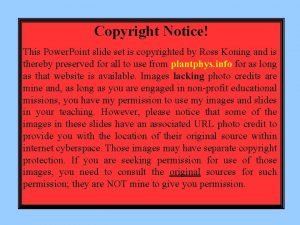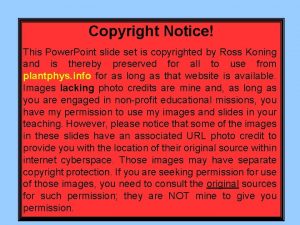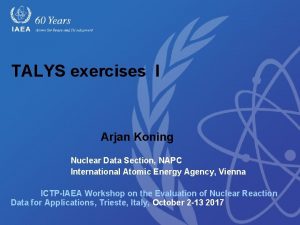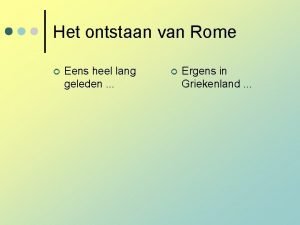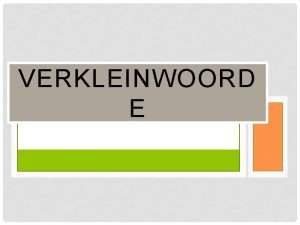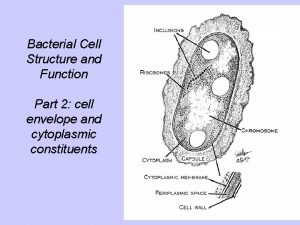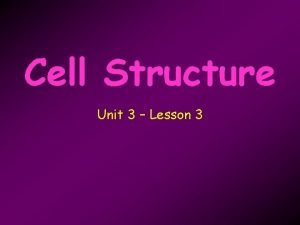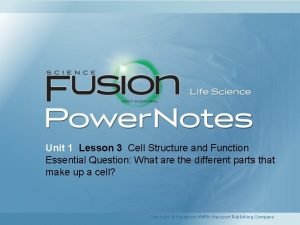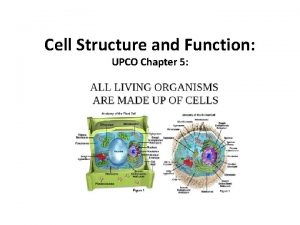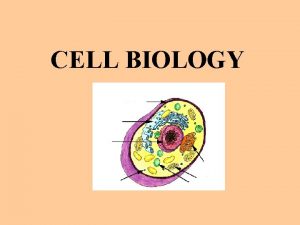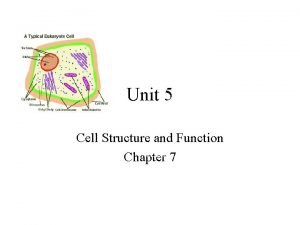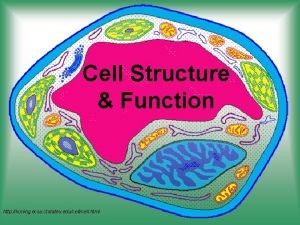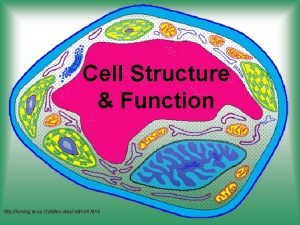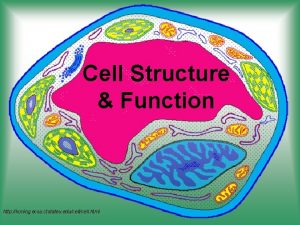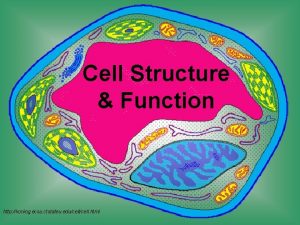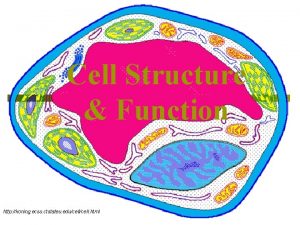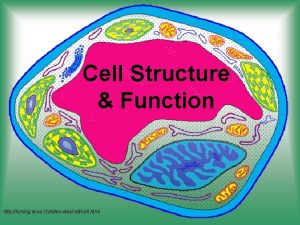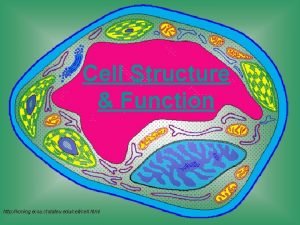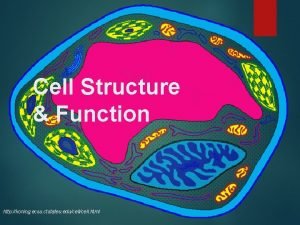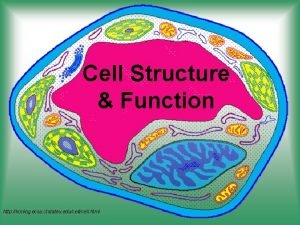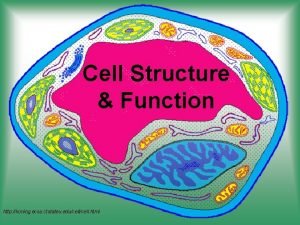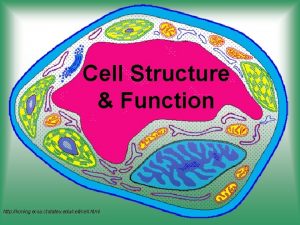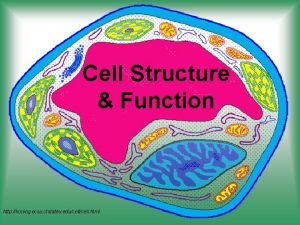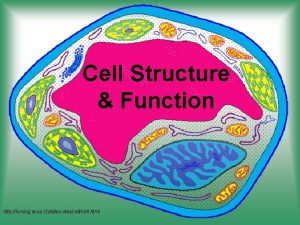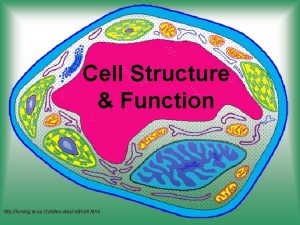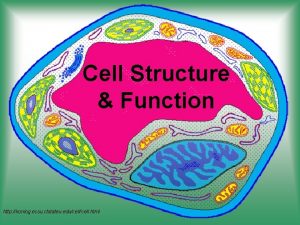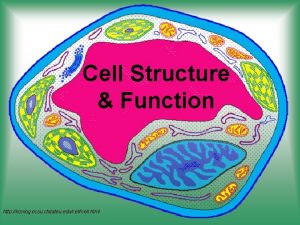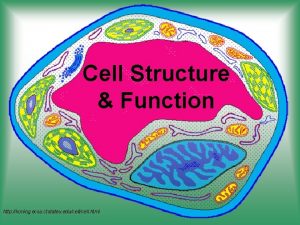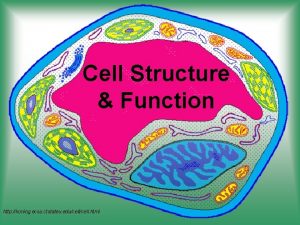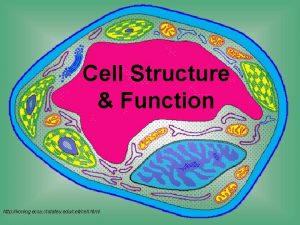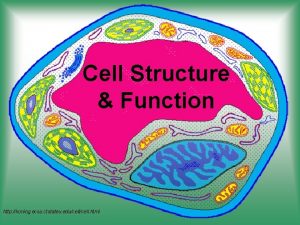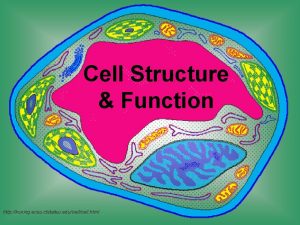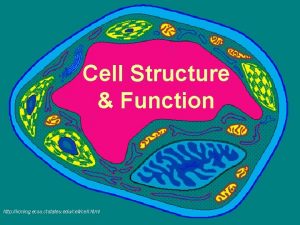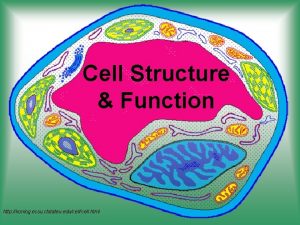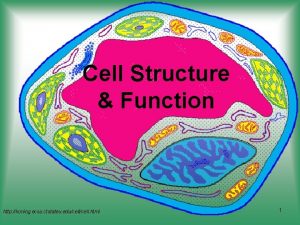Cell Structure Function http koning ecsu ctstateu educell


























- Slides: 26

Cell Structure & Function http: //koning. ecsu. ctstateu. edu/cell. html

Cell Theory • All living things are made up of cells. • Cells are the smallest working units of all living things. • All cells come from preexisting cells through cell division.

Definition of Cell A cell is the smallest unit that is capable of performing life functions.

Examples of Cells Amoeba (one celled animal) Plant Stem Bacteria Red Blood Cell Nerve Cell

Two Types of Cells • Prokaryotic Cells - prokaryotes • Eukaryotic Cells - eukaryotes

Prokaryotic Cell • • Few internal structures No nucleus One-celled organisms Bacteria are prokaryotes http: //library. thinkquest. org/C 004535/prokaryotic_cells. html

Eukaryotic Cell • Contain organelles surrounded by membranes • Most living organisms are eukaryotes • Have a nucleus Plant Cell http: //library. thinkquest. org/C 004535/eukaryotic_cells. html Animal Cell

Animal Cell Roundish in shape http: //web. jjay. cuny. edu/~acarpi/NSC/images/cell. gif

Plant Cell Angular in shape http: //waynesword. palomar. edu/images/plant 3. gif

Cell Parts are called organelles

Surrounding the Cell

Cell Membrane • Outer membrane of cell that controls movement in and out of the cell • Double layer http: //library. thinkquest. org/12413/structures. html

Cell Wall • Most commonly found in plant cells & bacteria • Supports & protects cells http: //library. thinkquest. org/12413/structures. html

Inside the Cell

Nucleus • Directs cell activities • Separated from cytoplasm by nuclear membrane • Contains genetic material - DNA

Nuclear Membrane • Surrounds nucleus • Openings allow material to enter and leave nucleus http: //library. thinkquest. org/12413/structures. html

Chromosomes • In nucleus • Made of DNA • Contain instructions for traits & characteristics http: //library. thinkquest. org/12413/structures. html

Cytoplasm • Gel-like mixture • Found outside nucleus but inside cell membrane • Where all organelles are suspended

Mitochondria • Produces energy through chemical reactions – breaking down fats & carbohydrates • Remember cellular respiration equation? ? Cell breaks down glucose to produce energy so the cell can do its job Glucose + oxygen carbon dioxide + water + ENERGY http: //library. thinkquest. org/12413/structures. html

Endoplasmic Reticulum • Moves materials around in cell • Smooth type: lacks ribosomes • Rough type (pictured): ribosomes embedded in surface http: //library. thinkquest. org/12413/structures. html

Ribosomes • Each cell contains thousands • Make proteins • Found on Endoplasmic reticulum & floating throughout the cell http: //library. thinkquest. org/12413/structures. html

Golgi Bodies • Protein 'packaging plant' • Move materials within the cell • Move materials out of the cell http: //library. thinkquest. org/12413/structures. html

Lysosome • Digestive 'plant' for proteins, fats, and carbohydrates • Transports undigested material to cell membrane for removal • Cell breaks down if lysosome explodes http: //library. thinkquest. org/12413/structures. html

Vacuoles • Membrane-bound sacs for storage, digestion, and waste removal • Animal cells have many small vacuoles • Plant cells have one large vacuole http: //library. thinkquest. org/12413/structures. html

Chloroplast • Found in plant cells • Contains green chlorophyll • Where photosynthesis takes place http: //library. thinkquest. org/12413/structures. html

Conclusion • All living things are made up of cells. • Cells are the smallest working units of all living things. • All cells come from preexisting cells through cell division.
 Eweb ecsu
Eweb ecsu Banner ecsu
Banner ecsu Eastern ct eweb
Eastern ct eweb Shirham
Shirham Cfidf
Cfidf Manlike vorm van hond
Manlike vorm van hond Giovanna koning
Giovanna koning Het jaar van de olifant islam
Het jaar van de olifant islam Poolse koning 1704
Poolse koning 1704 Arjan koning
Arjan koning De rechtmatige koning van alba longa heet
De rechtmatige koning van alba longa heet Meervoud van venster
Meervoud van venster Koning en koningin
Koning en koningin Rence damming
Rence damming Hans peter de koning
Hans peter de koning Middle lamella
Middle lamella What is part 2
What is part 2 Lesson 3 cell structure and function answer key
Lesson 3 cell structure and function answer key Cell organelle graphic organizer answer key
Cell organelle graphic organizer answer key Animal vs plant cell
Animal vs plant cell What cell is this
What cell is this Eukaryotic cell structure
Eukaryotic cell structure Chapter 7 cell structure and function section review 7-2
Chapter 7 cell structure and function section review 7-2 Cell organelle graphic organizer answer key
Cell organelle graphic organizer answer key Chapter 5 cell structure and function
Chapter 5 cell structure and function Plastids in plant cell
Plastids in plant cell Unit 5 cell structure and function answer key
Unit 5 cell structure and function answer key
